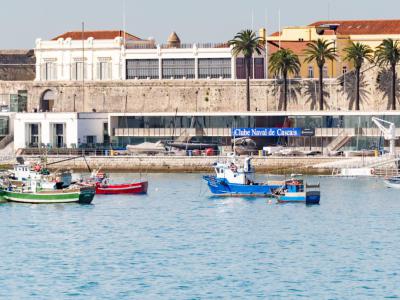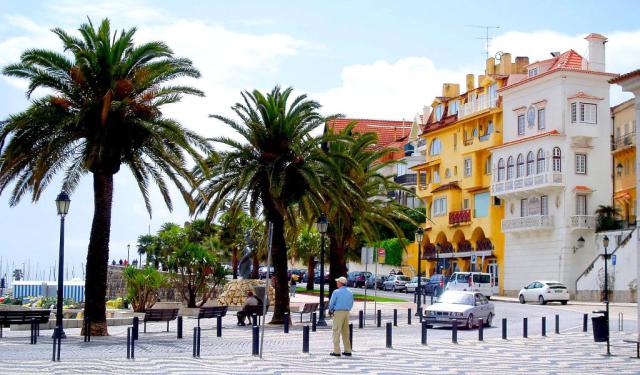Citadel of Cascais, Cascais
The Citadel of Cascais is a historic complex of fortifications built between the 15th and 17th centuries. It was originally constructed to safeguard the Cascais coastline and the estuary of the River Tagus. Its purpose was also to defend against potential attacks on Lisbon, the capital of Portugal.
The Citadel of Cascais comprises three distinct elements, each with its own unique history and significance:
Tower of Santo António de Cascais: The earliest construction on the site dates back to between 1410 and 1415. To address constant threats, especially from English forces, King John II of Portugal initiated the construction of a medieval-style tower on the Point of Salmodo, southwest of Cascais Bay. Known as the Torre de Santo António de Cascais, this tower was strategically positioned to collaborate with artillery ships and two other fortresses in the defense of Lisbon.
Fortress of Our Lady of Light (Nossa Senhora da Luz de Cascais): In 1594, during the reign of Philip I, the construction of the Fortress of Our Lady of Light was initiated. Designed by the Italian Captain Fratino, this fortress featured an unconventional triangular layout that ingeniously incorporated the existing Torre de Santo António de Cascais as one of its three bastions. The fortress included an inner courtyard that facilitated communication among the bastions, and it housed batteries, barracks, and cisterns.
Former Royal Palace Area: In the 19th century, King Luís I of Portugal directed the adaptation of the citadel for use as a royal retreat and resting place for the royal family and nobility. As part of this transformation, the royal palace area was constructed, which now serves as a museum. This period marked the rise of Cascais as a favored summer destination for affluent residents of Lisbon. Notably, in 1878, the Citadel became the first location in Portugal to be illuminated with electric lights.
Over the years, the Citadel of Cascais has seen various restorations and adaptations, integrating it into the modern landscape of the surrounding areas. It now serves as a captivating backdrop for the Cascais Marina. The complex includes a hotel and an Arts Centre known as the Cidadela Arts District.
The Citadel of Cascais comprises three distinct elements, each with its own unique history and significance:
Tower of Santo António de Cascais: The earliest construction on the site dates back to between 1410 and 1415. To address constant threats, especially from English forces, King John II of Portugal initiated the construction of a medieval-style tower on the Point of Salmodo, southwest of Cascais Bay. Known as the Torre de Santo António de Cascais, this tower was strategically positioned to collaborate with artillery ships and two other fortresses in the defense of Lisbon.
Fortress of Our Lady of Light (Nossa Senhora da Luz de Cascais): In 1594, during the reign of Philip I, the construction of the Fortress of Our Lady of Light was initiated. Designed by the Italian Captain Fratino, this fortress featured an unconventional triangular layout that ingeniously incorporated the existing Torre de Santo António de Cascais as one of its three bastions. The fortress included an inner courtyard that facilitated communication among the bastions, and it housed batteries, barracks, and cisterns.
Former Royal Palace Area: In the 19th century, King Luís I of Portugal directed the adaptation of the citadel for use as a royal retreat and resting place for the royal family and nobility. As part of this transformation, the royal palace area was constructed, which now serves as a museum. This period marked the rise of Cascais as a favored summer destination for affluent residents of Lisbon. Notably, in 1878, the Citadel became the first location in Portugal to be illuminated with electric lights.
Over the years, the Citadel of Cascais has seen various restorations and adaptations, integrating it into the modern landscape of the surrounding areas. It now serves as a captivating backdrop for the Cascais Marina. The complex includes a hotel and an Arts Centre known as the Cidadela Arts District.
Want to visit this sight? Check out these Self-Guided Walking Tours in Cascais. Alternatively, you can download the mobile app "GPSmyCity: Walks in 1K+ Cities" from Apple App Store or Google Play Store. The app turns your mobile device to a personal tour guide and it works offline, so no data plan is needed when traveling abroad.
Citadel of Cascais on Map
Sight Name: Citadel of Cascais
Sight Location: Cascais, Portugal (See walking tours in Cascais)
Sight Type: Attraction/Landmark
Guide(s) Containing This Sight:
Sight Location: Cascais, Portugal (See walking tours in Cascais)
Sight Type: Attraction/Landmark
Guide(s) Containing This Sight:
Walking Tours in Cascais, Portugal
Create Your Own Walk in Cascais
Creating your own self-guided walk in Cascais is easy and fun. Choose the city attractions that you want to see and a walk route map will be created just for you. You can even set your hotel as the start point of the walk.
Cascais Introduction Walking Tour
A charming seaside town some 30 minutes' drive away from the capital of Portugal, Cascais, holds a unique place in the country's history and culture. It started life as a humble fishing village, with the Romans, Visigoths, and Muslims leaving their mark on the area. Records dating back to Roman times suggest that it served as a stopover point for travelers along the coastline.
The... view more
Tour Duration: 2 Hour(s)
Travel Distance: 2.4 Km or 1.5 Miles
The... view more
Tour Duration: 2 Hour(s)
Travel Distance: 2.4 Km or 1.5 Miles




